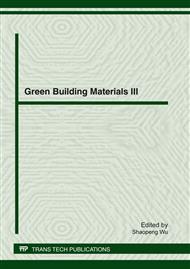p.1
p.6
p.13
p.20
p.26
p.33
p.40
p.45
Effect of Polycarboxylate Superplasticizer on Properties of Phosphogypsum-Based Cement
Abstract:
By using XRD、SEM and other experimental methods, some details of polycarboxylate superplasticizer on the hydration products and performance of phosphogypsum-based cement(PBC) can be obtained. It can be found that the polycarboxylate superplasticizer makes the structure of the cement stone more compact, and significantly increases the strength of the cement. Besides, it can also improve the anti-carbonation and degradation properties of that cement.
Info:
Periodical:
Pages:
13-19
Citation:
Online since:
April 2012
Authors:
Price:
Сopyright:
© 2012 Trans Tech Publications Ltd. All Rights Reserved
Share:
Citation:


